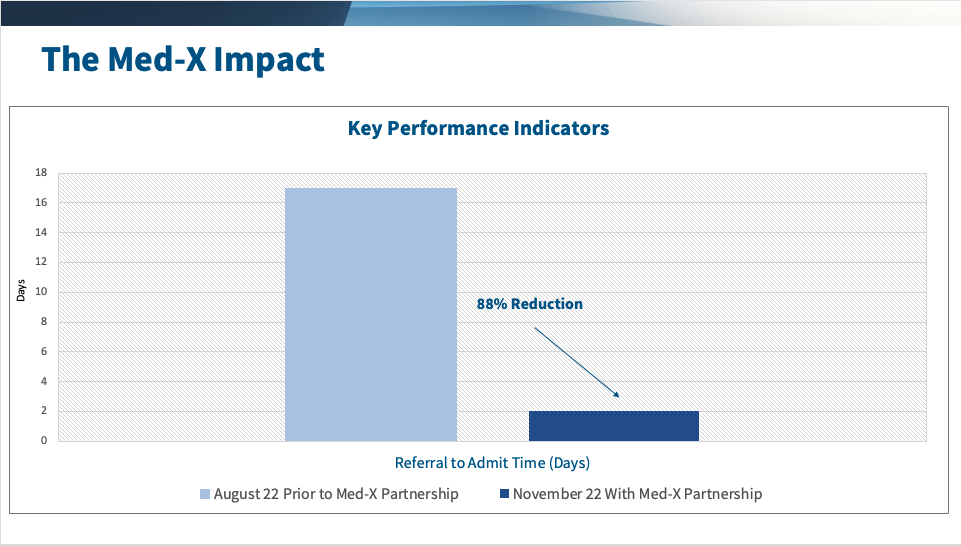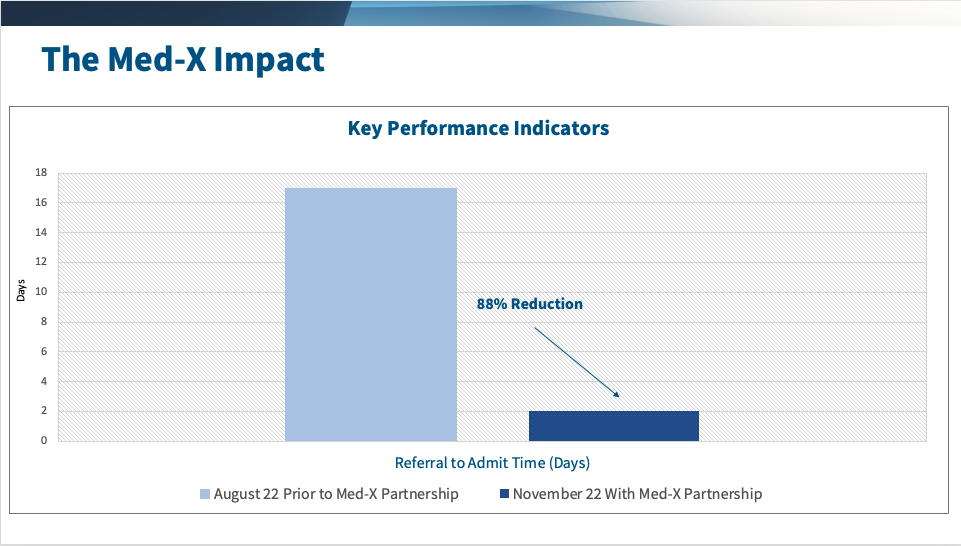Boosting Patient Numbers At An Eating Disorders Treatment Program
Overview
A specialized eating disorders treatment facility aimed to improve its patient intake processes to increase its average daily census and reduce delays in access to care.
In partnership with Med-X Consulting, the program implemented a series of targeted interventions, leading to a threefold increase in patient admissions and a 25% reduction in patients leaving against medical advice (AMA). Additionally, the referral-to-admission time decreased from 17 days to less than 48 hours, significantly improving patient access and treatment outcomes.
Introduction
Eating disorders are complex mental health conditions associated with high morbidity and mortality rates. According to the National Institute of Mental Health, the rising prevalence of these disorders demands urgent attention and expanded capacity for specialized treatment centers.
Timely access to care is crucial, as delays in treatment can exacerbate medical complications, increase comorbidities, and decrease treatment effectiveness (1).
Many eating disorder programs face operational challenges, including prolonged referral-to-admit times and inconsistent patient intake processes. These issues can harm patient outcomes, damage the facility’s reputation, and affect the program’s financial stability.
Streamlining the admission process can not only improve individual patient outcomes but also increase patient retention and ensure the sustainability of the treatment facility. This case study explores the successful collaboration between an eating disorders treatment program and Med-X Consulting to address these challenges through strategic interventions that transformed intake processes, accelerated admissions, and enhanced overall program performance.
Solution
The intervention began with a comprehensive analysis of the treatment facility’s existing intake protocols, examining both medical and operational workflows. From this assessment, three core strategies were developed and implemented:
- Pre-admission Medical Clinic: A dedicated pre-admission clinic was established to optimize the medical evaluation and assessment process for prospective patients. This clinic streamlined the intake process by addressing medical clearance requirements early, allowing for faster admissions.
- Development of Admission Protocols: In collaboration with the facility’s parent organization, new admission protocols were designed to standardize and accelerate patient intake. These protocols aimed to eliminate procedural bottlenecks and ensure the rapid yet safe transition of patients into treatment.
- Streamlining Case Review Process: We implemented measures to significantly reduce the time required to review cases for admission into care. By levaeraging technology and automating certain aspects of the review process, the time from referral to admission was significantly reduced.
Results
Within six months of implementing these strategies, the eating disorders program demonstrated remarkable improvements:
- Patient Volume: The average number of patients served tripled compared to the pre-intervention period, allowing the facility to meet the growing demand for care.
• Patient Retention: The rate of patients leaving AMA decreased by 25% each month, indicating improved patient satisfaction and engagement with treatment.
• Referral-to-Admit Time: The time from referral to admission dropped from an average of 17 days to less than 48 hours, significantly improving patient access to care.
The establishment of the pre-admission clinic facilitated timely evaluations, while the revised admission protocols ensured a smoother and more efficient intake process. Additionally, the streamlined case review process enabled the facility to admit patients without compromising safety or the quality of care provided.

Conclusion
The outcomes of this intervention highlight the importance of efficient intake processes in improving both patient outcomes and facility performance. Delays in admission can lead to worsened medical conditions, patient dissatisfaction, and revenue losses for the treatment program. The partnership with Med-X Consulting successfully addressed these challenges by implementing evidence-based strategies that enhanced both operational efficiency and clinical care.
A key factor in the success of this initiative was the establishment of a pre-admission clinic, which allowed for proactive management of medical assessments and reduced the bottlenecks often associated with intake processes. Additionally, the development of standardized admission protocols and the streamlining of case reviews ensured that patients were admitted swiftly, minimizing the potential for delays or administrative barriers.
This case study demonstrates the transformative impact of targeted operational improvements on an eating disorders treatment program. By focusing on pre-admission processes, the facility was able to increase its patient capacity, reduce dropout rates, and significantly improve the timeliness of care. These results highlight the importance of collaboration in healthcare settings, where operational and clinical expertise come together to enhance patient outcomes and service delivery.

References:
- Kazdin AE, Fitzsimmons-Craft EE, Wilfley DE. Addressing critical gaps in the treatment of eating disorders. Int J Eat Disord. 2017 Mar;50(3):170-189. doi: 10.1002/eat.22670. Epub 2017 Jan 19. PMID: 28102908; PMCID: PMC6169314.


